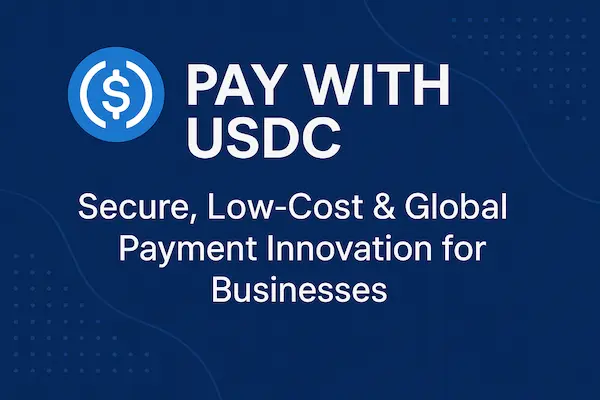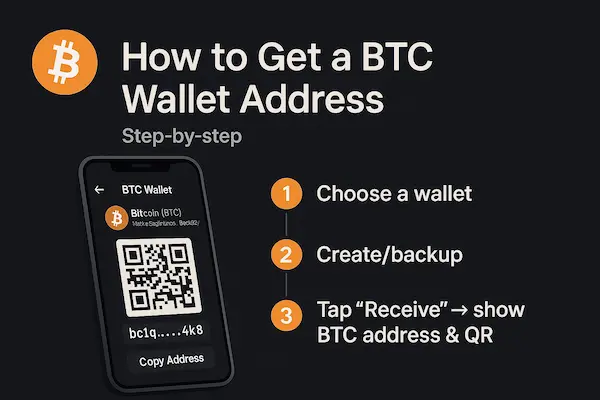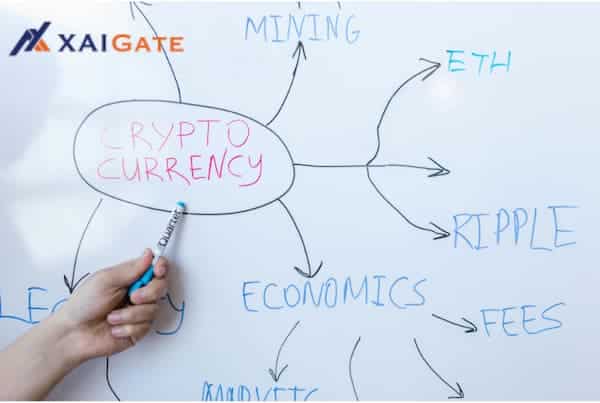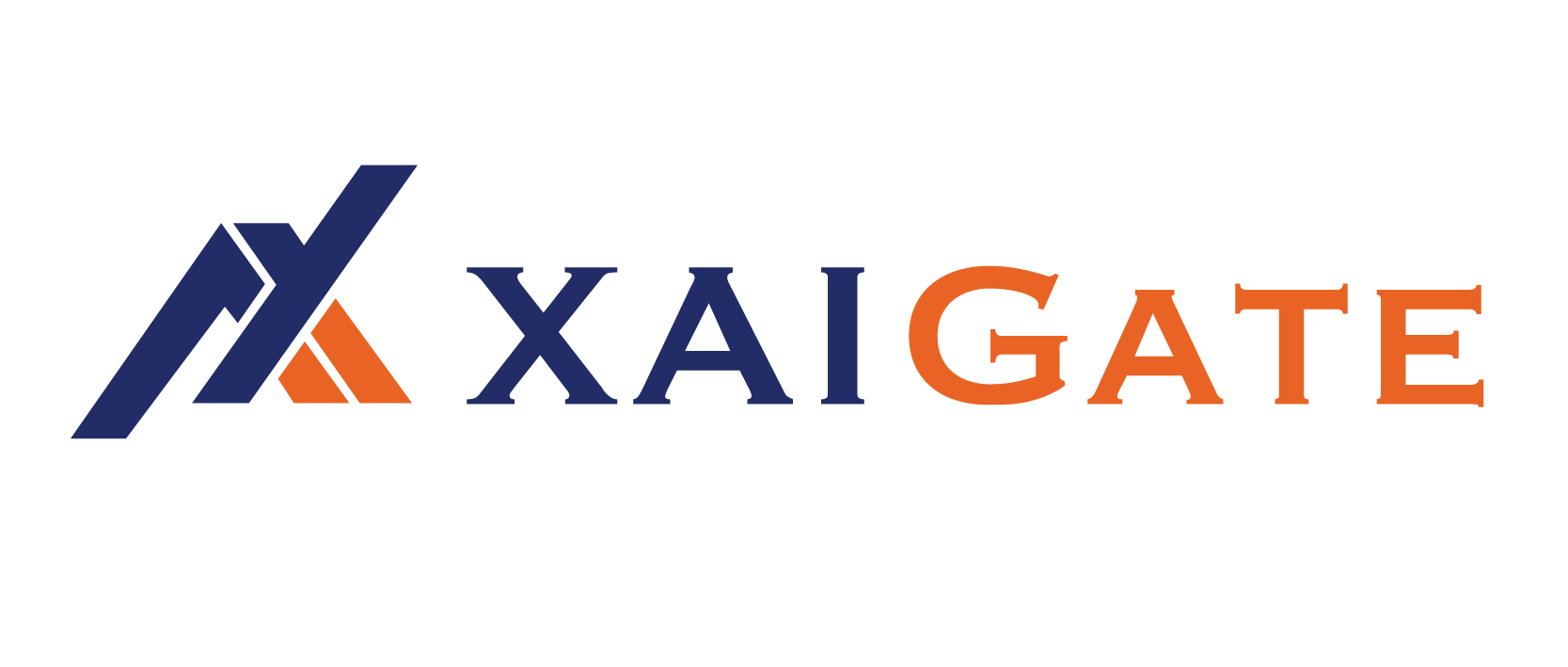Singapore has become one of the strictest yet most open fintech hubs. For merchants, the Payment Services Act Singapore crypto rules decide when accepting coins is just another checkout method and when it turns into a regulated financial service. This guide turns dense law into clear, practical steps.
Contents
- 1 1. Payment Services Act Singapore Crypto – Quick Answer for Busy Merchants
- 2 2. Understanding Singapore’s Payment Services Act for Crypto
- 3 3. Digital Payment Tokens – The Legal Bucket for Crypto Under the PSA
- 4 4. Do Merchants Need a Payment Services Licence to Accept Crypto?
- 5 5. Licensing Framework for DPT Services – SPI vs MPI for Crypto Players
- 6 6. Recent Regulatory Changes – PSA Amendments, DTSP Regime and What Comes Next
- 7 7. Core Compliance Obligations for Merchants Using Crypto Payment Gateways
- 8 8. Marketing and Promotions – Staying Within MAS Expectations
- 9 9. Designing a Compliant Crypto Payment Flow for Your Business
- 10 10. Sector-Specific Use Cases and Risk Profiles
- 11 11. Contracts, SLAs and Risk Allocation with Crypto PSPs and Gateways
- 12 12. Strategic Checklist – Should Your Business Accept Crypto Payments?
- 13 FAQs – Payment Services Act Singapore Crypto for Merchants
- 14 Conclusion: Quick Summary and Next Steps
1. Payment Services Act Singapore Crypto – Quick Answer for Busy Merchants
Most merchants care about one thing: can they accept crypto and stay safe. This section gives a fast, practical view of how the Payment Services Act Singapore crypto rules apply to real business payments.
1. One paragraph answer: how the Act treats crypto payments
In short, the Act regulates businesses that deal in or move digital payment tokens as a service. Most merchants do not need a licence if they accept crypto only through a regulated gateway, settle into fiat, and avoid holding or transferring tokens on behalf of customers.
table 1: PSA, FSMA and MAS guidance in one view
| Regime | Main focus | Who it targets | Merchant takeaway |
|---|---|---|---|
| PSA | Core payment services and DPTs | Onshore PSPs and gateways | Pick partners that are licensed under this law |
| FSMA | Overseas facing token services | DTSPs based in Singapore | Relevant if you run a cross border crypto platform |
| MAS guidance | Conduct, marketing, risk | Licensed DPT providers | Check your gateway’s policies match your own risk appetite |
2. When merchants are and are not providing regulated DPT services
A normal shop that lets customers pay in crypto through a licensed provider is usually not a DPT service provider. Risk rises when a merchant runs its own wallet, holds client tokens, or manages swaps between coins. At that point, licensing questions become serious.

2. Understanding Singapore’s Payment Services Act for Crypto
To see where your business stands, you first need to see how the Act is built. The Payment Services Act Singapore crypto framework is activity-based: it looks at what you actually do with money and tokens, not just what you call yourself.
1. Why Singapore uses this framework for fintech and digital assets
Singapore wanted one modern rulebook for cards, wallets, super apps and crypto. Instead of writing a new law for every product, it created a flexible Act that can cover both classic payments and digital payment tokens. For merchants, that means most day-to-day coin use is treated like a payment feature, not a new kind of bank.
2. The main regulated services and where digital tokens sit
The Act lists core services: account issuance, domestic and cross-border transfers, merchant acquiring, e-money and digital payment token services. Crypto sits in this last bucket. Once a business holds tokens for others, runs exchange functions or routes token transfers, it starts to touch the Payment Services Act Singapore crypto perimeter much more directly than a simple checkout button.
3. How the supervisor applies the Act in practice
One supervisor looks across banks, payment firms and token platforms using the same framework. Higher-risk activities get tighter rules and often a licence, while low-risk merchant use stays lighter. The easiest path for most merchants is to stay firmly in the “merchant” role and work with partners whose licences and controls already fit the Payment Services Act Singapore crypto environment.
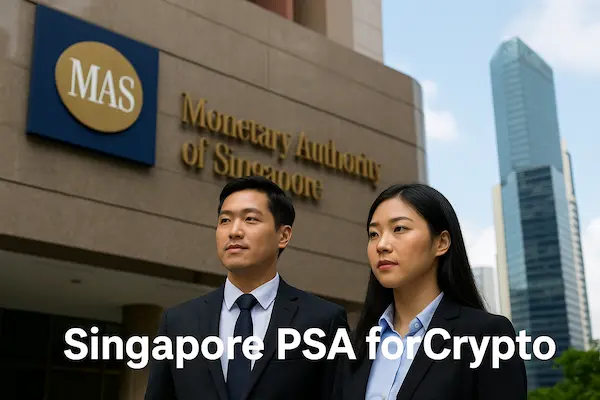
3. Digital Payment Tokens – The Legal Bucket for Crypto Under the PSA
Before diving into details, it helps to see where digital payment tokens sit in the wider rulebook. The table below compares the main regimes that shape how the Payment Services Act Singapore crypto framework works in practice and what each one means for merchants.
Table 2 – Comparing PSA, FSMA and SFA for crypto activity
| Framework | Main focus in practice | Who it mainly applies to | Typical examples | What it means for merchants |
|---|---|---|---|---|
| PSA | Core payment services, including digital payment tokens | Payment institutions, gateways and many hosted wallets | Crypto payment gateways, exchanges, merchant acquirers | Choose partners that sit clearly and comfortably under this law |
| FSMA | Digital token services with an overseas client focus | Providers in Singapore serving mainly foreign users | Global trading platforms, cross-border token services | Relevant if your platform is built here but targets foreign users |
| SFA | Capital markets and investment-style products | Issuers and intermediaries for security-like tokens | Security token offerings, derivatives, structured products | Matters if tokens look more like investments than pure payments |
1. Legal definition of a digital payment token in simple terms
In simple terms, a digital payment token is a digital unit of value that people accept as a means of exchange. It can be stored in a wallet, sent across a network and traded for other tokens or money. It is more than a closed loyalty point. Once a token is freely transferable and priced by the market, it is likely to sit inside the Payment Services Act Singapore crypto perimeter, even if its brand or technology changes over time.
2. What kinds of crypto activity become regulated DPT services
The law does not chase every person who buys coffee with coins. It focuses on businesses that handle tokens as a service for others: running an exchange, matching buyers and sellers, routing transfers between users or holding customer tokens in custody. Once a firm offers these activities as its business model, it looks like a digital payment token provider and not just a normal user under the Payment Services Act Singapore crypto rules.
3. DPT service providers vs merchants who simply accept coins
A DPT service provider usually sits in the middle of the market. It may operate hosted wallets, run an order book or plug a gateway into thousands of merchant sites. It designs and controls the rails that value moves on. A merchant that only accepts coins through a licensed partner, shows clear prices and keeps clean records is using that system rather than running it. In that simpler setup, most everyday merchants stay outside the licensing net, while their partners carry the heavy regulatory obligations of the Payment Services Act Singapore crypto framework.
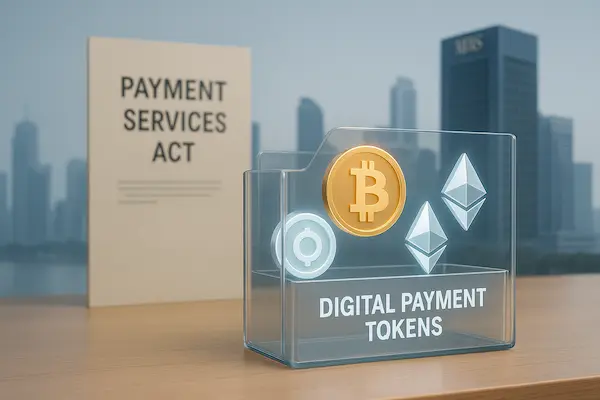
4. Do Merchants Need a Payment Services Licence to Accept Crypto?
This is the first question most finance and legal teams ask. Under the Payment Services Act Singapore crypto framework, the answer depends less on which coin you accept and more on how your business touches that coin before and after each payment.
1. Common merchant use cases for crypto payments in Singapore
Typical patterns include a web shop using a crypto gateway plug in, a cafe that shows a QR code from a wallet app, or a SaaS platform that lets users pay invoices in coins. Each case moves value, but not every setup creates a regulated DPT service.
2. When accepting crypto is not treated as a regulated DPT service
If you only let customers pay through a licensed gateway, settle quickly into fiat, and never hold or move tokens for others, you are usually outside the licensing net. Your main duties are then commercial: clear prices, honest wording and fair dispute handling.
3. When a merchant may trigger licensing questions under the PSA
Regulatory risk rises when a merchant runs pooled wallets, keeps client tokens for later use, or lets users swap between different coins inside its own system. At that point the business starts to look like a DPT provider, and licence analysis becomes essential.

5. Licensing Framework for DPT Services – SPI vs MPI for Crypto Players
Behind the scenes of many merchant solutions sit licensed payment institutions. The law offers different tiers so that smaller firms and large global platforms do not face exactly the same obligations. For many commercial teams this structure rarely appears in sales decks, yet it shapes how much oversight sits behind each product. Understanding how these tiers work helps merchants read their partners’ licences and see how the Payment Services Act Singapore crypto system manages risk while still leaving room for innovation.
1. Why the law uses different tiers of payment institution licences
Not every provider handles the same scale of funds or risk. A small specialist gateway that serves a limited set of clients has a very different footprint from a global exchange with millions of users. By splitting providers into tiers, the law can apply lighter rules to modest-scale businesses and tighter, bank-like expectations to the biggest platforms. From a Payment Services Act Singapore crypto perspective, this tiering is what keeps the barrier to entry reasonable for new gateways while still protecting customers at scale.
2. How standard and major payment institutions differ in practice
A standard payment institution can handle only up to certain volume thresholds in a set of regulated services. Once it grows beyond those limits, or takes on more complex activities, it needs to move up into a major payment institution licence. That shift usually brings higher capital, governance and reporting expectations and closer day to day scrutiny. Merchants may not see all of this detail, but their choice of partner decides which part of the licensing ladder supports their own crypto payment flows. Reading licence conditions with a basic understanding of this structure is therefore a useful skill for any leadership team.
3. What merchants should look for in the licences held by their partners
When a merchant chooses a crypto gateway, it is not just buying software. It is also buying into the partner’s regulatory status, risk culture and resilience. Checking which licences a provider holds, which services are covered, and whether it is staying within those limits is part of sensible vendor due diligence under the Payment Services Act Singapore crypto framework. In practice, merchants that ask these questions early are less likely to face sudden service cuts if a provider falls foul of its obligations, and more likely to keep regulators and auditors comfortable as volumes grow.
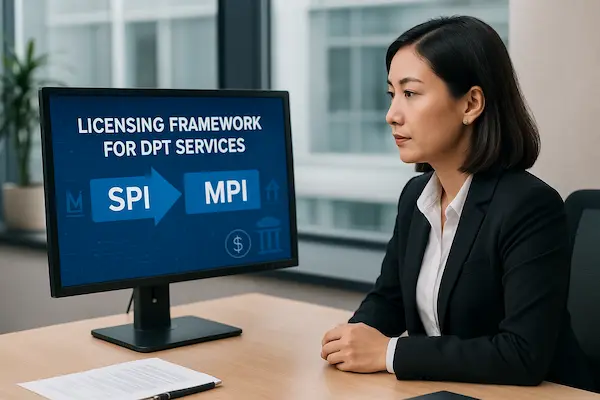
6. Recent Regulatory Changes – PSA Amendments, DTSP Regime and What Comes Next
In the last couple of years, rules around the Payment Services Act Singapore crypto landscape have become sharper. More token activities now sit clearly inside regulation, and a separate layer has appeared for firms that mainly serve overseas clients. Merchants still see a simple checkout, but the bar for their partners is higher.
1. PSA amendments and a tighter digital payment token perimeter
Recent amendments widened what counts as a regulated digital payment token service. It is no longer only about running an exchange. Helping users move tokens between wallets, holding tokens in custody, or arranging swaps for others can now fall under the payment services regime. For merchants, this mainly means that the gateways and platforms behind a crypto button face stronger rules on custody, disclosure and user protection.
2. The DTSP regime under FSMA Part 9
A separate regime now covers digital token service providers based in Singapore that mostly serve overseas customers. These firms need a specific licence and must meet high standards on governance, risk and financial crime controls. If a merchant uses a “global” platform built in Singapore, it is worth checking whether that partner falls into this category, because changes in its licence status can quickly affect the merchant’s own crypto payment options.
3. Looking ahead: stablecoins and a more tokenised payment stack
Supervisors have also signalled next steps, including a dedicated stablecoin framework and pilots for tokenised forms of money and assets. Over time, crypto and tokenised instruments are likely to sit more firmly inside mainstream regulation rather than at the edge. Merchants that already understand their role under the Payment Services Act Singapore crypto framework, choose well-licensed partners and document their payment flows will be better placed to plug into these new rails as they mature.
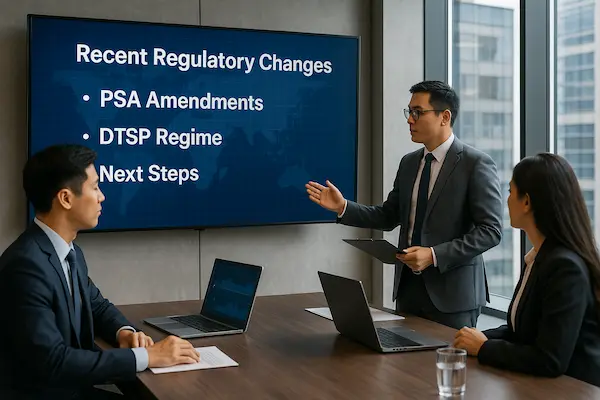
7. Core Compliance Obligations for Merchants Using Crypto Payment Gateways
Even if a gateway carries most of the regulatory weight, a merchant still has basic duties. In any Payment Services Act Singapore crypto setup, you are expected to choose solid partners, keep sensible records and treat customers fairly.
1. Working with properly licensed PSPs and crypto gateways
Start by checking who you plug into. Confirm where the provider is based, what licence it holds and which activities that licence actually covers. Keep a short internal note on each key partner so you can show, if asked, that you picked providers that sit cleanly inside the Payment Services Act Singapore crypto framework.
2. Light-touch AML, sanctions and record-keeping
You are not a bank, but you should still notice obvious red flags: fake names, strange order patterns, repeated chargebacks. Have a simple way to pause orders and ask questions when something feels wrong. Keep invoices, settlement reports and basic customer data long enough to satisfy tax, audit and, in rare cases, law-enforcement queries.
3. Consumer protection, disclosures and refunds
Customers mainly care about clarity. Explain how you set prices, when the exchange rate is locked and who handles refunds if a payment fails. Say whether refunds are in fiat, tokens or store credit. Short, plain-English wording on your checkout and terms shows that you understand the risks of using volatile assets and that your business is acting responsibly within the Payment Services Act Singapore crypto environment.
8. Marketing and Promotions – Staying Within MAS Expectations
Promoting crypto payments is not the same as promoting trading. In a Payment Services Act Singapore crypto setup, regulators are wary of hype, gambling style messages and anything that pushes retail users into taking risk they do not understand. Your copy and visuals should feel calm, factual and clearly focused on payments, not speculation.
1. Keep messaging about payments, not “getting rich”
Your website and app should describe crypto as “one more way to pay”, not as an investment tip. Avoid language about quick profits, winning big or beating the market. Focus on convenience, speed, cross-border reach and customer choice. Screenshots and banners should show checkout flows, not price charts or rockets.
2. Be clear, balanced and boring on risk
Where you talk about coins, add one or two short, visible lines on risk: prices can move, refunds may work differently and customers should only pay amounts they can afford. Keep this wording simple enough that a non-technical user can understand it in one read. That tone of calm, balanced explanation fits well with the Payment Services Act Singapore crypto framework and shows you are not trying to exploit volatility.
3. Align your UX with your risk story
Do not hide key information in tiny footers or behind five clicks. Put pricing, fees and basic risk wording close to the payment button. Make it easy for users to see which currencies are supported and how exchange rates are chosen. A clean, honest UX is often the best evidence that your brand treats crypto payments as a serious, supervised part of commerce rather than a game or a bet.
9. Designing a Compliant Crypto Payment Flow for Your Business
A good crypto setup is not just a plug in. It is a mapped flow where everyone knows their role. If you design the journey with the Payment Services Act Singapore crypto rules in mind, you reduce risk and make it easier to explain your model to boards, banks and auditors.
1. Map your current payment journey
Start with your normal flow. From the first click at checkout to funds in your bank, list each step, each system and each party. Then add a crypto lane on top of that map. Mark who talks to the customer, who sets prices, who touches tokens and who holds any private keys. This picture shows where regulation is likely to bite and where you remain a simple merchant.
2. Insert licensed partners in the right places
Next, decide where a licensed gateway or payment institution should sit. In most cases, the partner should handle pricing in coins, routing transactions, managing custody and settling net amounts to you. Your systems stay focused on orders, invoicing and customer support. In a clean Payment Services Act Singapore crypto flow, the merchant never runs pooled wallets or complex token routing. Those pieces stay with firms that are built and licensed for that job.
3. Test, document and review the end to end flow
Once the design looks clear on paper, run a few internal test payments. Check that invoices, confirmations and settlement reports all line up, and that staff know how to answer basic customer questions. Write a short internal note describing the flow, the licences you rely on and the key risks you have considered. Reviewing this note once or twice a year keeps your setup aligned with the evolving Payment Services Act Singapore crypto environment and makes later audits much easier.
10. Sector-Specific Use Cases and Risk Profiles
Not every merchant faces the same level of scrutiny. Under the Payment Services Act Singapore crypto framework, risk depends a lot on your sector, ticket size, customer base and how often people pay in coins rather than fiat.
1. Retail and e-commerce merchants
For most shops and online stores, crypto is just one more way to pay. Ticket sizes are modest, orders are frequent and fraud patterns look similar to card payments. The main issues are clear pricing, refunds and customer support. If you use a licensed gateway, keep volumes sensible and avoid pushing customers into speculative use of tokens, your Payment Services Act Singapore crypto exposure is usually low and manageable.
2. Cross-border, travel and service businesses
Travel, education, freelancing and other cross-border services often see higher value invoices and clients from many countries. Crypto can help with speed and FX, but it also raises sanctions, AML and tax questions. In this space, it is smart to map which corridors you serve, which tokens you allow and which partners you rely on. Documenting that thinking shows you take your Payment Services Act Singapore crypto obligations seriously and are not using tokens to dodge normal controls.
3. Higher-risk sectors and extra controls
Some models sit closer to the line: gaming, investment-style platforms, NFT marketplaces, high-yield schemes. Here, users may treat tokens as bets or investments rather than simple payment tools. Even if you call yourself a “merchant”, regulators may look harder at how you market, how you hold funds and who really bears the risk. In these cases, you should expect stricter KYC, tighter limits and more questions about where you fit in the Payment Services Act Singapore crypto landscape, and be ready to adjust the model if it drifts too close to full financial intermediation.
11. Contracts, SLAs and Risk Allocation with Crypto PSPs and Gateways
Behind every smooth crypto checkout there is a contract. If you want a stable Payment Services Act Singapore crypto setup, your agreement with the gateway has to match the story you tell regulators, banks and customers.
1. Key clauses every merchant should look for
At minimum, your contract should spell out which services the partner provides, which licences it relies on, uptime targets, settlement timelines and fee structures. Make sure it is clear who owns customer data, how disputes are handled and which law governs the contract. If the document is vague, ask for tighter wording before going live.
2. Allocating AML, sanctions and customer protection duties
The agreement should say who is responsible for KYC, sanctions screening, transaction monitoring and reporting suspicious activity. It should also clarify who handles customer complaints, chargebacks and failed transactions. In a clean Payment Services Act Singapore crypto model, the gateway takes the heavy regulatory tasks, while the merchant focuses on fair communication and good customer care.
3. Exit, de-risking and business continuity
No provider lasts forever, so plan for change from day one. Build in notice periods, data export rights and a clear process if the gateway loses its licence or changes its risk appetite. Keep a short list of backup providers and avoid deep technical lock-in. A simple, well-drafted exit clause can save a lot of pain if your primary partner suddenly has to step back from crypto services.
12. Strategic Checklist – Should Your Business Accept Crypto Payments?
Not every merchant needs a crypto button. A short, honest review is often enough to decide whether it fits your goals under the Payment Services Act Singapore crypto framework or just adds noise.
1. Clarify the real business case
Ask why you want crypto at all. Is it to serve specific customer segments, cut FX costs, speed up cross-border settlement, or just to look modern? Estimate how much revenue could realistically move into tokens and how often those customers would use it. If the upside is vague or tiny, it may not justify new processes, vendor risk and staff training.
2. Line up legal, tax and accounting early
Before launch, get short written views from legal, tax and finance. Map how crypto invoices are priced, recognised and reported, and how refunds work. Check that contracts, privacy notices and internal policies all tell the same story. A simple one-page note on how your setup fits within the Payment Services Act Singapore crypto environment can save time later with banks, auditors and investors.
3. Use a simple go / no-go decision
Turn the discussion into a few clear questions: do we have a strong business case, a licensed partner we trust, and staff who understand the basics? Are we comfortable explaining this model to our board and our main bank? If the answer is “yes” across those points, start small with a pilot and review after a few months. If not, park the idea and revisit when your strategy, partners or the regulatory landscape have moved on.
FAQs – Payment Services Act Singapore Crypto for Merchants
Many teams have the same core questions before they launch a crypto payment pilot. The FAQs below keep things short and practical so you can scan them quickly and see how your model sits under the Payment Services Act Singapore crypto framework.
1. Do merchants in Singapore need a licence to accept crypto payments?
Usually no, if you only accept coins through a licensed gateway and do not hold or route tokens for others. In that setup, your partner is the regulated provider and you are treated as a normal merchant.
2. Under the Payment Services Act, what counts as a regulated DPT service?
It becomes regulated when a business runs an exchange, routes token transfers, or holds customer tokens in custody as a paid service. Casual use of crypto to pay for goods is not the target.
3. Can a merchant hold customer tokens without a DPT licence?
Holding pooled customer tokens or balances on your own platform is risky. That kind of setup can look like a DPT service and may require a licence before it scales.
4. Is it safer to use a licensed gateway than to accept crypto directly?
For most merchants, yes. A licensed gateway is built to handle custody, technology risk and AML work that would otherwise sit on your own team.
5. How do stablecoins fit into this picture?
Many stablecoins are treated like other digital payment tokens for now. If you or your partners run exchange, custody or transfer services in them, the same logic usually applies.
6. Are merchants allowed to offer discounts for crypto payments?
Pricing is mostly a commercial choice, but the messaging matters. Keep offers framed around payments and service, not around betting on token prices.
7. What should a board review before approving a crypto pilot?
The board should see the business case, the chosen partners, a simple flow map and key risks. One short memo is often enough for a first decision.
8. How often should merchants review their crypto payment setup?
A light review once or twice a year is usually enough. Check partner licences, volumes, use cases and whether your contracts and customer wording still match how the service really works.
Conclusion: Quick Summary and Next Steps
If you treat the Payment Services Act Singapore crypto rules as part of normal governance – not a side project – crypto can sit safely in your payment stack. The goal is simple: stay a merchant, let licensed partners run the rails, and keep your story clear for banks, auditors and customers.
Quick summary table for merchants
| Area | What you should remember |
|---|---|
| Your role | Stay a merchant, not a DPT provider. Let licensed partners run the rails. |
| Partners | Work only with clearly licensed PSPs/gateways and document that choice. |
| Flows and custody | Avoid pooled wallets and holding client tokens unless you want regulation. |
| Compliance & records | Keep simple AML red flags, clean invoices and settlement reports. |
| Customer experience | Be clear on pricing, FX, risk and refunds in plain English. |
| Regulatory direction | Expect tighter rules and more tokenisation over time; review your setup. |
What to do this month
In the next 30 days you can quietly put a real Payment Services Act Singapore crypto strategy in place:
- Map one simple flow of how a crypto payment moves from customer to your bank.
- List your key partners, their licences and which services you rely on.
- Update checkout text and FAQs so prices, FX and refunds are clear and boringly honest.
- Brief your CFO/legal lead with the flow map and the table above, then set a review date.
Do that, and crypto becomes a supervised, explainable crypto payments option in your business – not a risky experiment you hope no one asks about.
For daily updates, subscribe to XAIGATE’s blog!
We may also be found on GitHub, and X (@mxaigate)!



